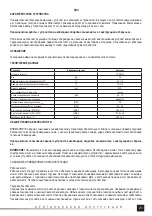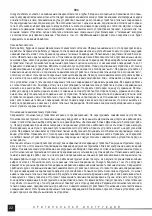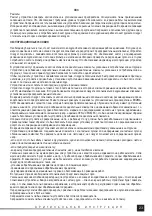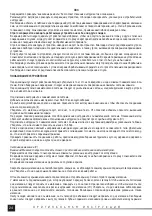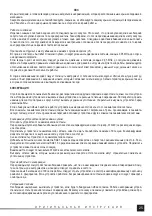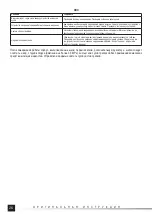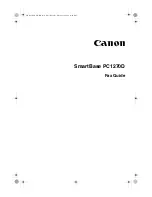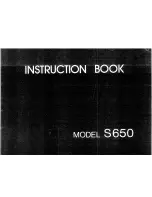
11
O
P
E
R
A
T
I
N
G
M
A
N
U
A
L
GB
pressed air tank. Avoid contact of the power supply cord with heat sources, oils, sharp edges or mobile elements. Do not power the
pneumatic tool with oxygen, infl ammable or toxic gases. Use only fi ltered and “lubricated” compressed air whose pressure may be
regulated. Make sure that the processed object is properly fi xed and will not move during processing.
Personal safety
Work in good physical and psychological condition. Pay attention to what you are actually doing. Do not work if you are tired or
under infl uence of medicines or alcohol. Even a moment of distraction during work may lead to serious injuries. Use personal
protection. Wear protective goggles. Using personal protections like anti-dust masks, protective shoes, helmets or hearing protec-
tor reduces the risk of serious injuries. While operating a pneumatic tool, wear protective gloves in order to protect yourself from
mechanic injuries and thermal infl uence of the tool. Avoid starting the tool by chance. Make sure the switch is in the position „OFF”,
before the tool is connected to the compressed air tank. Keeping a fi nger on the switch or connecting of the tool when the switch is
in the position “ON” may cause serious injuries. Before the pneumatic tool is connected, remove all the wrenches and other tools
that were used for adjustments. A wrench that is left on mobile parts of the tool may cause serious injuries. Keep balance. During
the whole period of work, keep an appropriate position. It will facilitate the operation of the pneumatic tool in the case of unpre-
dictable situations during work. Use protective clothes. Do not wear loose clothes or jewellery. Keep the hair, clothes and gloves
away from the mobile parts of the tool. Loose clothes, jewellery or long hair may get caught in the mobile parts of the tool. Use
dust removing systems and dust containers if the tool is equipped with them. Connect it correctly. A dust removing system dimin-
ishes the risk of serious injuries. The feeding duct is under pressure what may cause its dynamic movements and serious injuries.
Operating of a pneumatic tool
Do not use the tool in a manner that does not correspond to its purpose. Do not overload the pneumatic tool. Use a proper tool
for a given job. Do not exceed the maximum acceptable working pressure. A proper choice of tool for a given job will guarantee
more effi cient and safer operation. Before the tool is regulated, accessories changed or the tool stored, the feeding duct must be
disconnected. Thus the pneumatic tool is protected from casual switching it on. Store the tools away from children. Do not permit
operation of the tool by persons that have not been trained as far as its operation is concerned. The tool must be properly main-
tained. Check the tool for lack of adjustment and play of mobile parts. Check if any element of the tool is damaged. In the case if
any defects are detected, they must be repaired before the pneumatic tool may be used. Many accidents are caused by incorrect
maintenance of tools. Cutting tools must be kept clean and sharp. Properly kept cutting tool is easier to control during operation.
Use pneumatic tools and accessories with accordance to the above mentioned instructions. Use the tools with accordance to their
purpose, taking into account the type and conditions of work. Using the tools for purposes that diff er from those for which they
were designed, increases the risk of dangerous situation. While operating a pneumatic tool, take into account a possibility of frac-
turing the working tool, what may cause expulsion of its parts at a high velocity and lead to serious injuries. Make sure the tool is
rotating in a correct direction. Unexpected direction of rotation may be a cause of a dangerous situation. Do not place hands near
the mobile elements of the pneumatic tool, since it may cause serious injuries. In the case the socket of the collector is damaged,
there is a risk of expulsion of parts of the tool at a high velocity and lead to serious injuries. As result of the turning moment, the
tool or the reaction stick may turn. It may lead to serious injuries if the body of the operator is within the range of the turning tool
or the reaction stick. Adopt an appropriate position during work and be prepared for a turn of the tool. Solely the equipment that
is destined to function with pneumatic tools may be used. Using inappropriate equipment may lead to serious injuries. In the case
the power supply is suddenly interrupted, the switch of the tool must be immediately released.
Repair
The tool may be repaired solely in authorised service points which use only original spare parts. It will guarantee an appropriate
level of safety of the pneumatic tool. Do not clean the pneumatic tool with petrol, solvents or another infl ammable liquid. The fumes
may ignite causing an explosion of the tool and serious injuries. The tool may only be maintained with high quality materials. It is
prohibited to use substances other than those mentioned in the service manual. Before the inserted tool is replaced or dismantled,
disconnect the compressed air supply duct.
CONDITIONS OF OPERATION
It is indispensable that the source of compressed air permits generating of the appropriate working pressure. Should the pressure
of the fed air be too high, it is necessary to use a reducer with a safety valve. The pneumatic device must be supplied with com-
pressed air through a fi lter and lubricator system. It will guarantee both cleanliness and lubrication of the air with oil. The conditions
of the fi lter and the lubricator must be revised between each use and, if necessary, clean the fi lter or replenish oil in the lubricator.
It will guarantee appropriate operation of the machine and prolong its durability.
It is only allowed to use in the tools only those connecting elements that are specifi ed in the manual. The tool which is used to
drive connecting elements and the connecting elements specifi ed in the manual are considered to constitute a single system from
the point of view of safety.
In order to connect the tool to the pneumatic system, it is recommended to use snapping connections, and the tool itself should
have a non-sealing screwed connector, so that after the tool has been disconnected, there is no remaining air in it.
The tool must not be supplied with oxygen or other infl ammable gases.
Tools should be connected solely to such a supplying system in which it is not possible to exceed the pressure by more than 10%
Содержание YT-09213
Страница 22: ...22 RUS...
Страница 23: ...23 RUS 10 CEN CENELEC...
Страница 24: ...24 RUS SAE 10 II IV 13 8 V VII...
Страница 25: ...25 RUS VI 0 05 a 0 05 a WD 40 30 SAE 10 SAE 10 WD 40 6 100...
Страница 26: ...26 RUS 0 3 MPa...
Страница 28: ...28 UA K...
Страница 29: ...29 UA 10 CEN CENELEC...
Страница 30: ...30 UA SAE 10 II IV 13 8 V VII VI 0 05 a 0 05 a...
Страница 31: ...31 UA WD 40 30 SAE 10 SAE 10 WD 40 6 100 0 3 MPa...
Страница 84: ...84 GR...
Страница 85: ...85 GR 10 O CEN CENELEC E i...
Страница 86: ...86 GR SAE 10 II IV 13 8 bar V VII VI 0 05 MPa 0 05 MPa...
Страница 87: ...87 GR WD 40 30 SAE 10 SAE 10 WD 40 6 100 0 3 MPa...
Страница 91: ...I N S T R U K C J A O R Y G I N A L N A 91...
Страница 92: ...I N S T R U K C J A O R Y G I N A L N A 92...





















